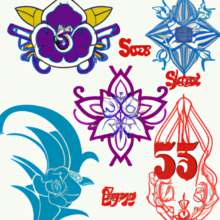Application Techniques Of Tattoos
Tattoos have been a form of self-expression and body art for centuries. From ancient civilizations to modern times, people have been adorning their bodies with permanent ink designs. However, the process of getting a tattoo has evolved over time, and so have the techniques used for application. In this article, we will explore the various application techniques of tattoos and how they have changed over the years.
The first and most traditional technique of tattoo application is hand-poking. This method involves using a sharp tool, such as a needle or a stick, to manually insert ink into the skin. Hand-poking is a slow and meticulous process, and it requires a skilled artist to create intricate designs. This technique has been used by many cultures throughout history, including the Polynesians, who used it to create traditional tribal tattoos.
Another popular technique is machine tattooing, also known as electric tattooing. This method uses a tattoo machine, which is a handheld device that rapidly punctures the skin with needles to deposit ink. The machine is powered by an electric motor and can create a more consistent and precise application compared to hand-poking. This technique was first invented in the late 1800s and has since become the most common method of tattoo application.
In recent years, a new technique called stick and poke has gained popularity. This method is similar to hand-poking, but instead of using a single needle, a group of needles is attached to a stick or a pen-like device. The artist dips the needles into ink and then manually punctures the skin to create the design. Stick and poke tattoos are often smaller and simpler in design, and they have a more rustic and homemade look compared to machine tattoos.
One of the most significant advancements in tattoo application techniques is the use of rotary machines. These machines use a rotary motor instead of an electromagnetic one, making them quieter and smoother in operation. Rotary machines also have adjustable needle depth, allowing for more control and precision during the application process. This technique is preferred by many artists for its versatility and ability to create both fine lines and shading.
Another technique that has gained popularity in recent years is watercolor tattoos. This method involves using a combination of watercolor paints and tattoo ink to create a unique and vibrant design. Watercolor tattoos require a skilled artist who can blend colors seamlessly and create a design that mimics the look of a painting. This technique is relatively new and has become a favorite among those looking for a more artistic and unconventional tattoo.
In addition to the various application techniques, there are also different types of needles used in tattooing. The most common type is the round shader needle, which is used for shading and filling in large areas. The round liner needle is used for creating fine lines and details, while the magnum needle is used for both shading and lining. The type of needle used depends on the design and style of the tattoo, and a skilled artist will know which one to use for the best results.
The application technique used also depends on the location of the tattoo on the body. For example, areas with thinner skin, such as the fingers, require a lighter touch and a slower application process to avoid damaging the skin. On the other hand, areas with thicker skin, such as the back or thighs, can handle a more aggressive application technique.
In conclusion, the application techniques of tattoos have come a long way from the traditional hand-poking method. With advancements in technology and the introduction of new techniques, tattoo artists now have more options to create unique and intricate designs. Whether it’s hand-poking, machine tattooing, or watercolor tattoos, each technique has its own advantages and can produce stunning results. So, if you’re thinking of getting a tattoo, make sure to research the different techniques and choose an artist who is skilled in the one you prefer. After all, a tattoo is a permanent piece of art on your body, and it’s essential to choose the right technique for the best outcome.



